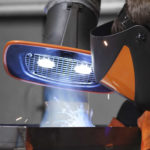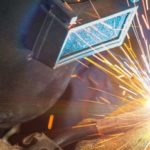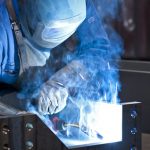Strong generation of fume during welding with covered rod electrodes
The manual arc welding with covered rod electrode is a very popular welding method. However, more welding fume is generated here than in many other methods. This means greater hazard for the health.
In the manual arc welding a rod electrode is used as additional material, through which the electric current is conducted to the welding location. Depending on the weld seam, a certain rod electrode must be used. The electrodes consist of a metal core and a coating. They are differentiated on the basis of the so-called coating types: acid coat, alkaline coat, cellulose coat and rutile coat. In addition, there are mixed types as well as a differentiation with respect to the thickness of the coating. There is a total of twelve rod electrode classes.
During the application of the method, it is worked with welding transformer or rectifier. The welder has an electrode holder in which he inserts the mostly 350 mm long electrode. During the welding process, the electrode and the coating are melting, so that slag is formed, which is deposited on the weld seam and protects it. The coating of the rod electrode must stabilise and ionise the arc during the welding. In addition, the coating protects the welded object from particles from the air.
The manual arc welding leads, independently of the coating of the rod electrode, to strong generation of fume – stronger than, for example, in the case of the gas-shielded welding. This means: a large amount of hazardous substances in the form of particles, which endanger the health of the welder and the workers at the neighbouring workplaces who do not participate in the welding works. Therefore, the use of an adequate suction device with spot extraction is particularly important.





